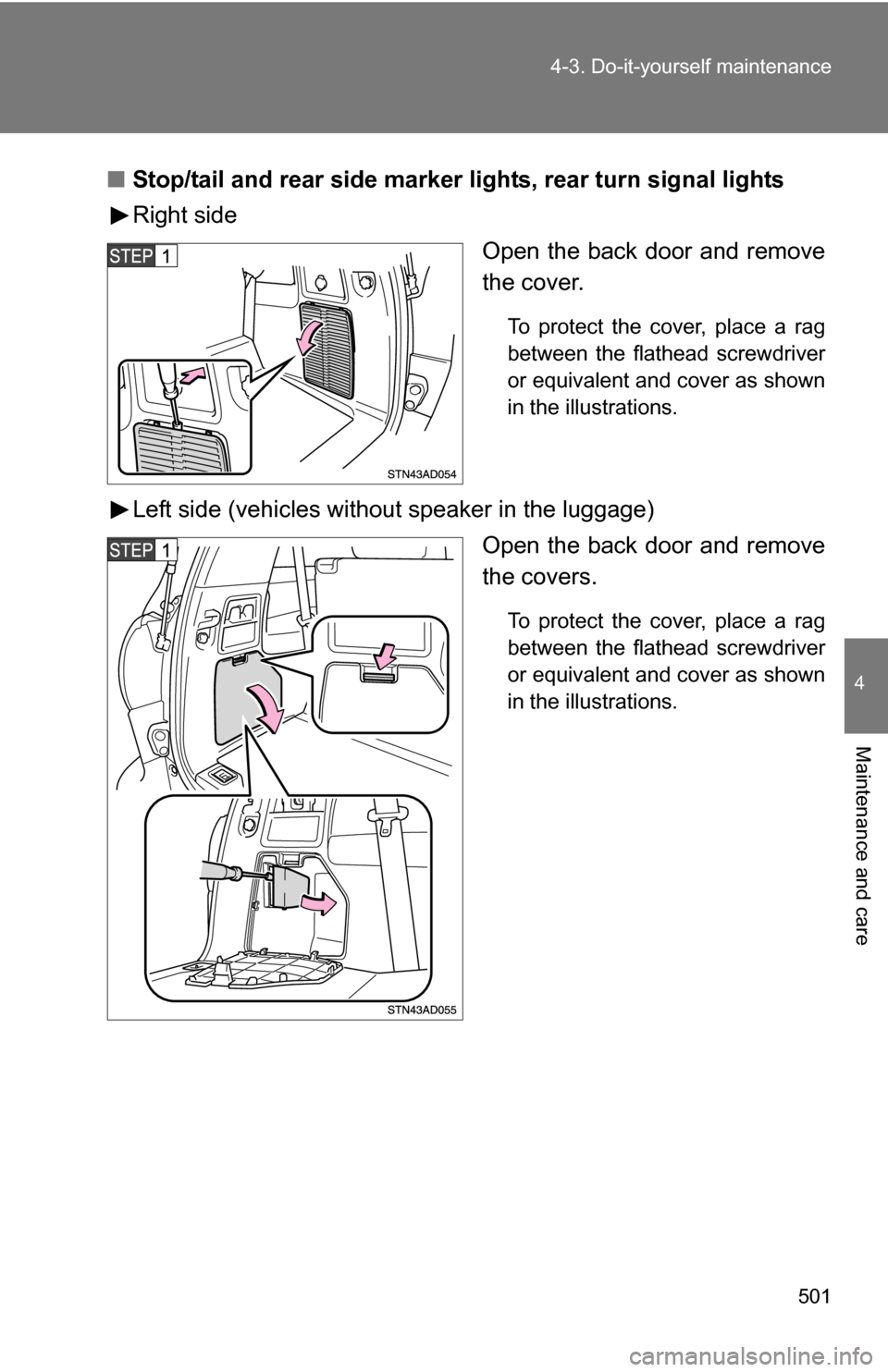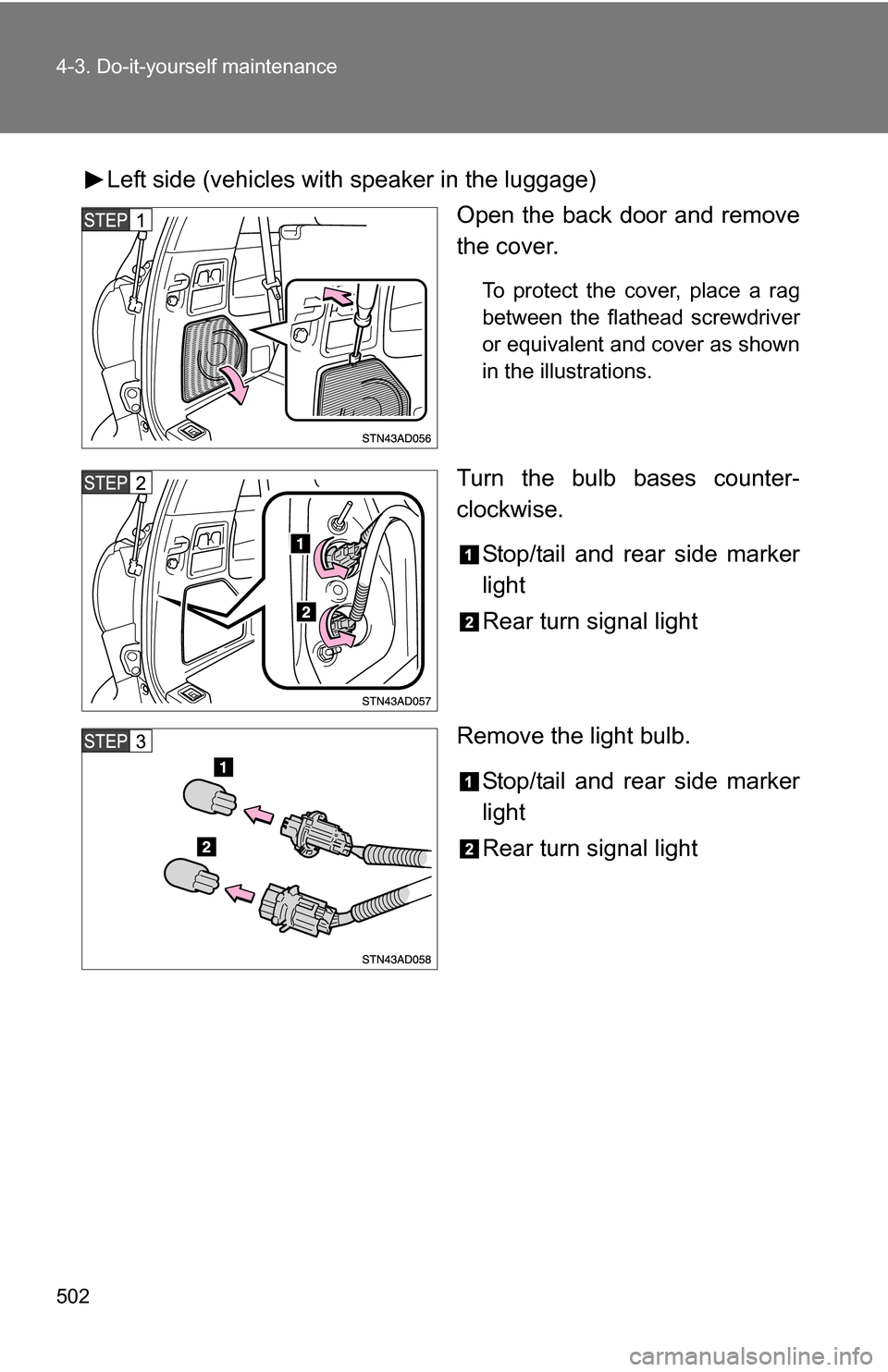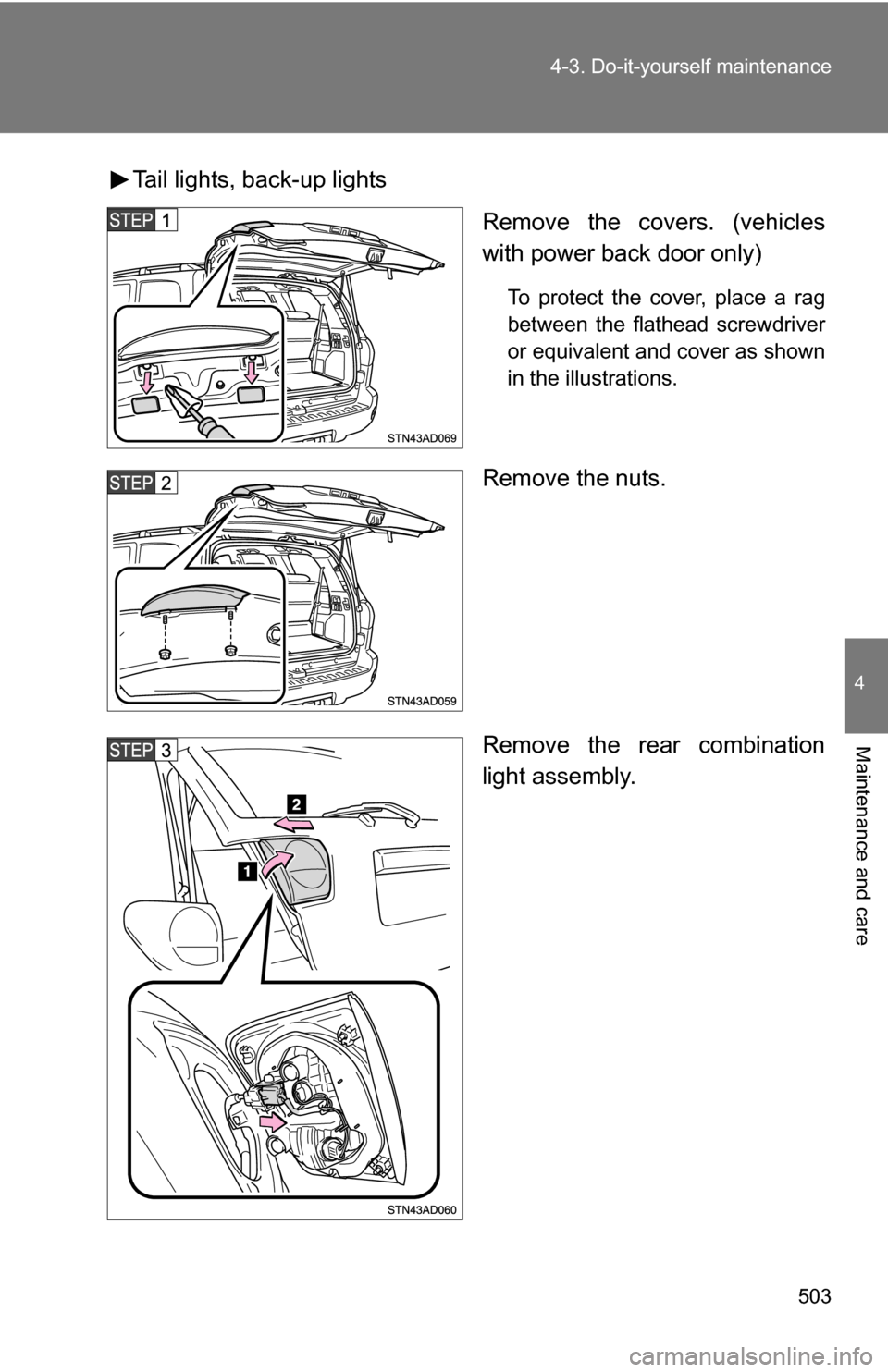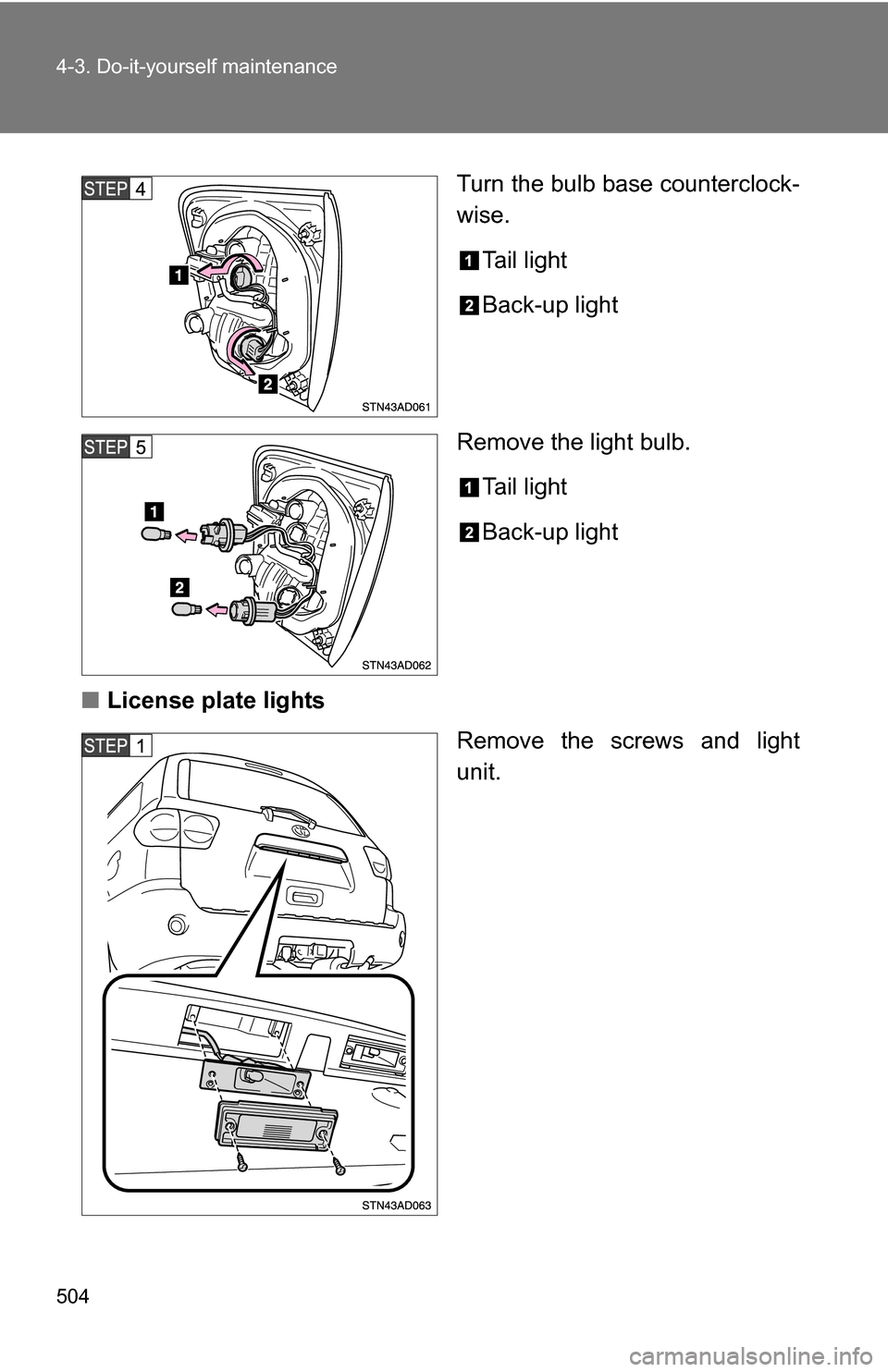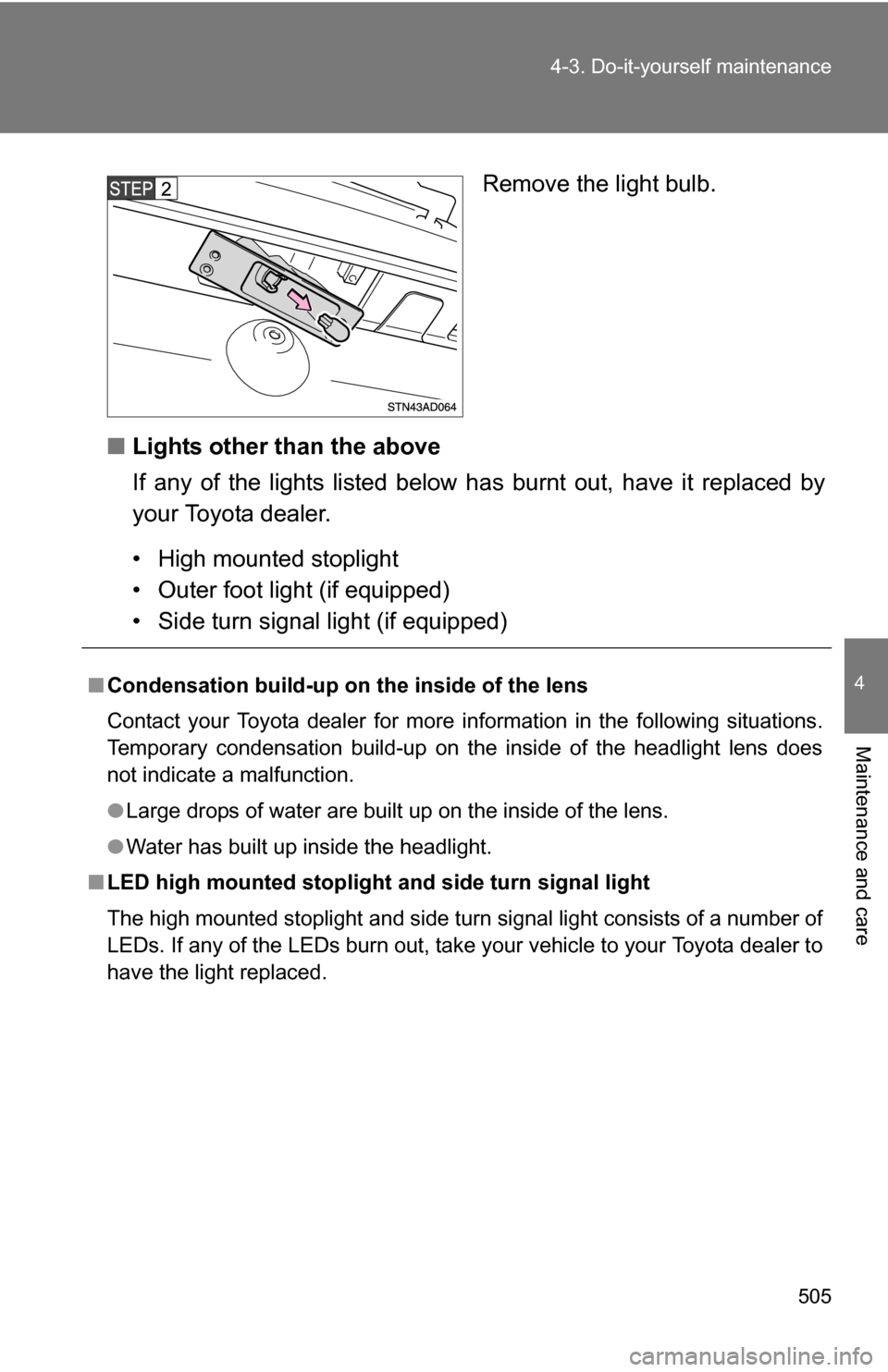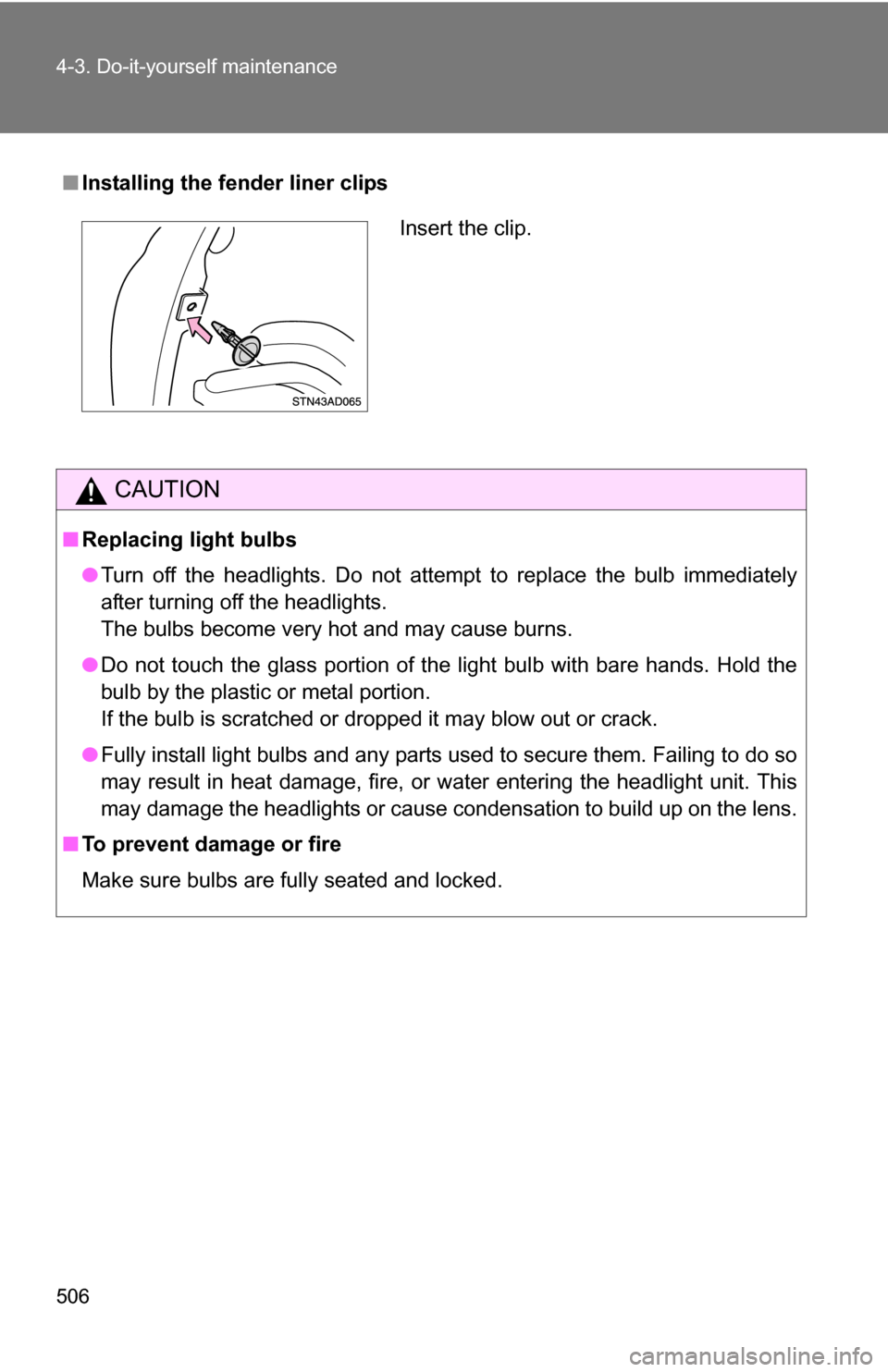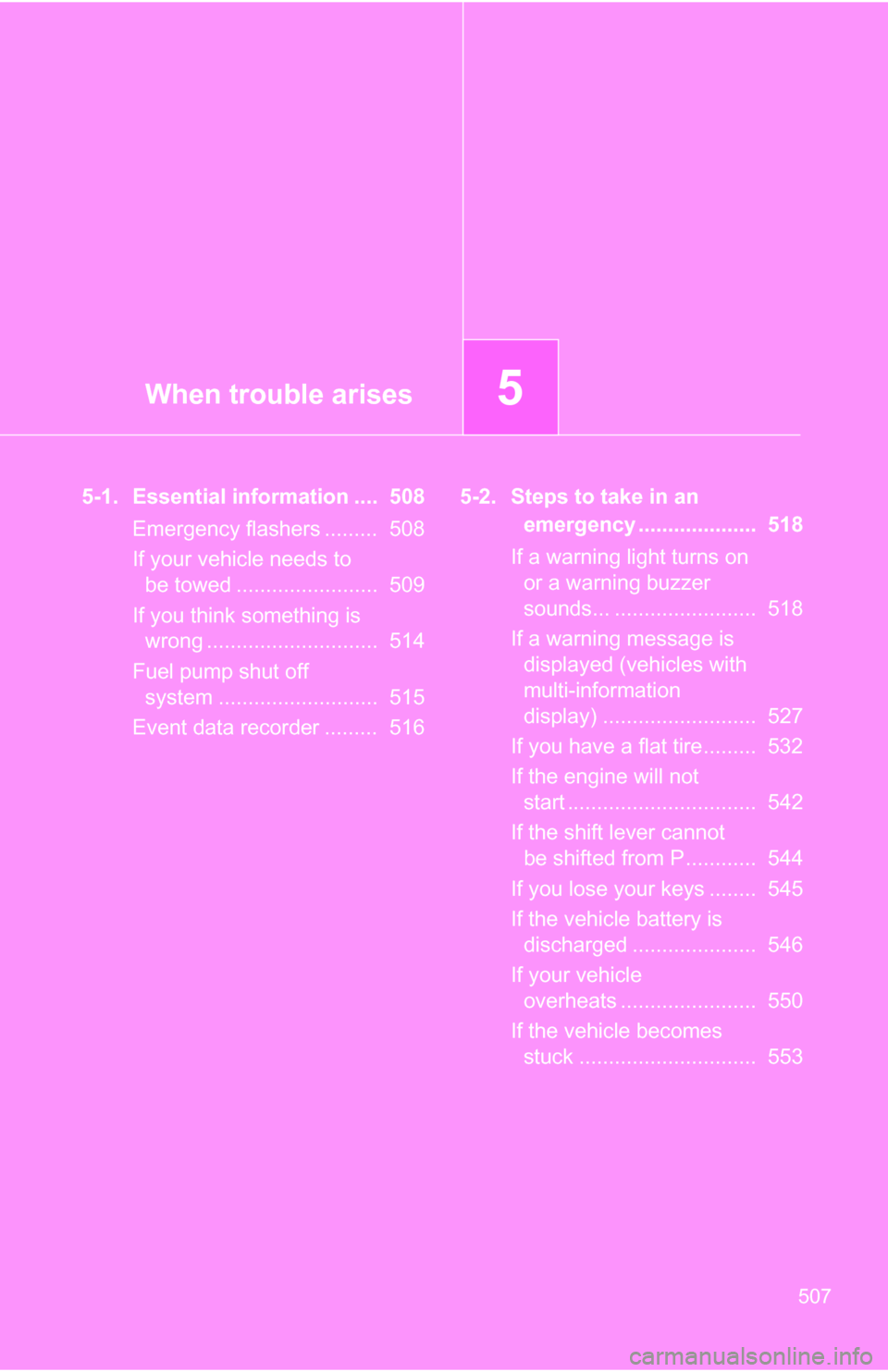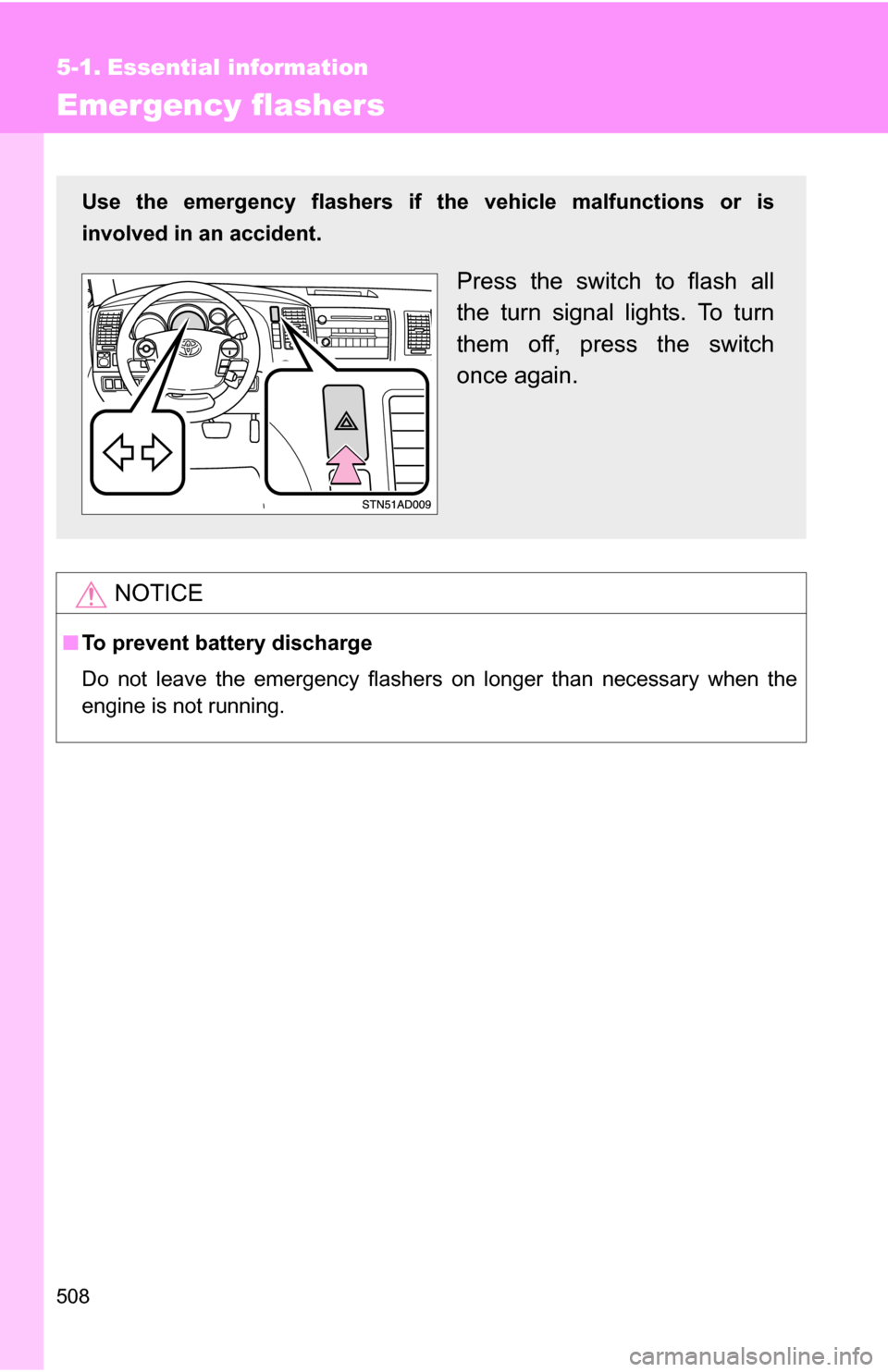TOYOTA SEQUOIA 2009 2.G Owners Manual
SEQUOIA 2009 2.G
TOYOTA
TOYOTA
https://www.carmanualsonline.info/img/14/6756/w960_6756-0.png
TOYOTA SEQUOIA 2009 2.G Owners Manual
Trending: child lock, service indicator, power steering, child seat, belt, display, lights
Page 501 of 612
501
4-3. Do-it-yourself maintenance
4
Maintenance and care
■
Stop/tail and rear side marker lights, rear turn signal lights
Right side
Open the back door and remove
the cover.
To protect the cover, place a rag
between the flathead screwdriver
or equivalent and cover as shown
in the illustrations.
Left side (vehicles without speaker in the luggage)Open the back door and remove
the covers.
To protect the cover, place a rag
between the flathead screwdriver
or equivalent and cover as shown
in the illustrations.
Page 502 of 612
502 4-3. Do-it-yourself maintenance
Left side (vehicles with speaker in the luggage)Open the back door and remove
the cover.
To protect the cover, place a rag
between the flathead screwdriver
or equivalent and cover as shown
in the illustrations.
Turn the bulb bases counter-
clockwise.
Stop/tail and rear side marker
light
Rear turn signal light
Remove the light bulb. Stop/tail and rear side marker
light
Rear turn signal light
Page 503 of 612
503
4-3. Do-it-yourself maintenance
4
Maintenance and care
Tail lights, back-up lights
Remove the covers. (vehicles
with power back door only)
To protect the cover, place a rag
between the flathead screwdriver
or equivalent and cover as shown
in the illustrations.
Remove the nuts.
Remove the rear combination
light assembly.
Page 504 of 612
504 4-3. Do-it-yourself maintenance
Turn the bulb base counterclock-
wise.Tail light
Back-up light
Remove the light bulb. Tail light
Back-up light
■ License plate lights
Remove the screws and light
unit.
Page 505 of 612
505
4-3. Do-it-yourself maintenance
4
Maintenance and care
Remove the light bulb.
■ Lights other than the above
If any of the lights listed below has burnt out, have it replaced by
your Toyota dealer.
• High mounted stoplight
• Outer foot light (if equipped)
• Side turn signal light (if equipped)
■ Condensation build-up on th e inside of the lens
Contact your Toyota dealer for more information in the following situations.
Temporary condensation build-up on the inside of the headlight lens does
not indicate a malfunction.
● Large drops of water are built up on the inside of the lens.
● Water has built up inside the headlight.
■ LED high mounted stoplight and side turn signal light
The high mounted stoplight and side turn signal light consists of a number of
LEDs. If any of the LEDs burn out, take your vehicle to your Toyota dealer to
have the light replaced.
Page 506 of 612
506 4-3. Do-it-yourself maintenance
■Installing the fender liner clips
CAUTION
■Replacing light bulbs
●Turn off the headlights. Do not attempt to replace the bulb immediately
after turning off the headlights.
The bulbs become very hot and may cause burns.
● Do not touch the glass portion of the light bulb with bare hands. Hold the
bulb by the plastic or metal portion.
If the bulb is scratched or dropped it may blow out or crack.
● Fully install light bulbs and any parts used to secure them. Failing to do so
may result in heat damage, fire, or water entering the headlight unit. This
may damage the headlights or cause condensation to build up on the lens.
■ To prevent damage or fire
Make sure bulbs are fully seated and locked.
Insert the clip.
Page 507 of 612
When trouble arises5
507
5-1. Essential information .... 508Emergency flashers ......... 508
If your vehicle needs to be towed ........................ 509
If you think something is wrong ............................. 514
Fuel pump shut off system ........................... 515
Event data recorder ......... 516 5-2. Steps to take in an
emergency .................... 518
If a warning light turns on or a warning buzzer
sounds... ........................ 518
If a warning message is displayed (vehicles with
multi-information
display) .......................... 527
If you have a flat tire......... 532
If the engine will not start ................................ 542
If the shift lever cannot be shifted from P............ 544
If you lose your keys ........ 545
If the vehicle battery is discharged ..................... 546
If your vehicle overheats ....................... 550
If the vehicle becomes stuck .............................. 553
Page 508 of 612
508
5-1. Essential information
Emergency flashers
NOTICE
■To prevent battery discharge
Do not leave the emergency flashers on longer than necessary when the
engine is not running.
Use the emergency flashers if th e vehicle malfunctions or is
involved in an accident.
Press the switch to flash all
the turn signal lights. To turn
them off, press the switch
once again.
Page 509 of 612
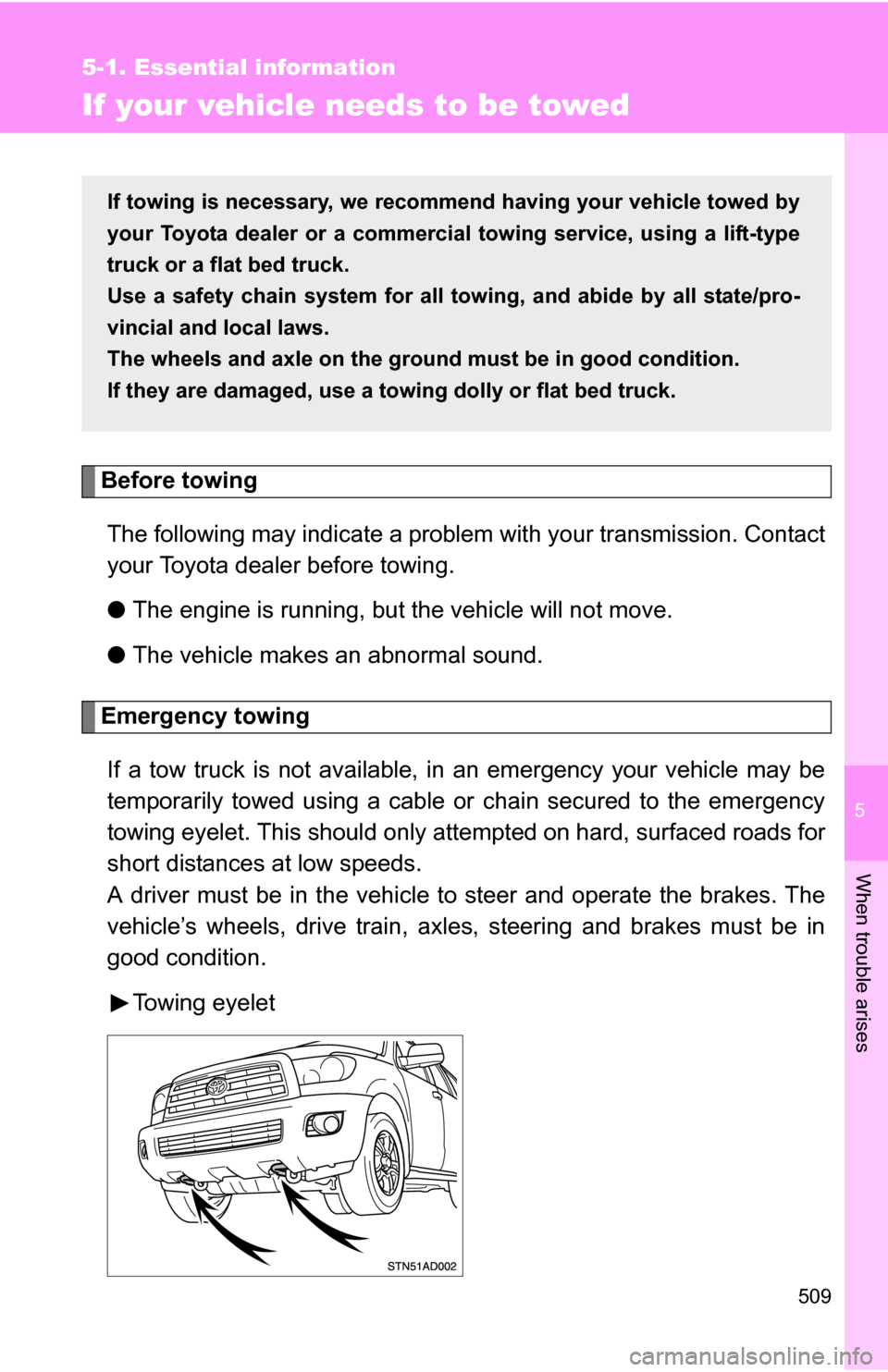
5
When trouble arises
509
5-1. Essential information
If your vehicle needs to be towed
Before towingThe following may indicate a problem with your transmission. Contact
your Toyota dealer before towing.
● The engine is running, but the vehicle will not move.
● The vehicle makes an abnormal sound.
Emergency towing
If a tow truck is not available, in an emergency your vehicle may be
temporarily towed using a cable or chain secured to the emergency
towing eyelet. This should only attempted on hard, surfaced roads for
short distances at low speeds.
A driver must be in the vehicle to steer and operate the brakes. The
vehicle’s wheels, drive train, axles, steering and brakes must be in
good condition.
Towing eyelet
If towing is necessary, we recommend having your vehicle towed by
your Toyota dealer or a commerci al towing service, using a lift-type
truck or a flat bed truck.
Use a safety chain system for all to wing, and abide by all state/pro-
vincial and local laws.
The wheels and axle on the groun d must be in good condition.
If they are damaged, use a towing dolly or flat bed truck.
Page 510 of 612
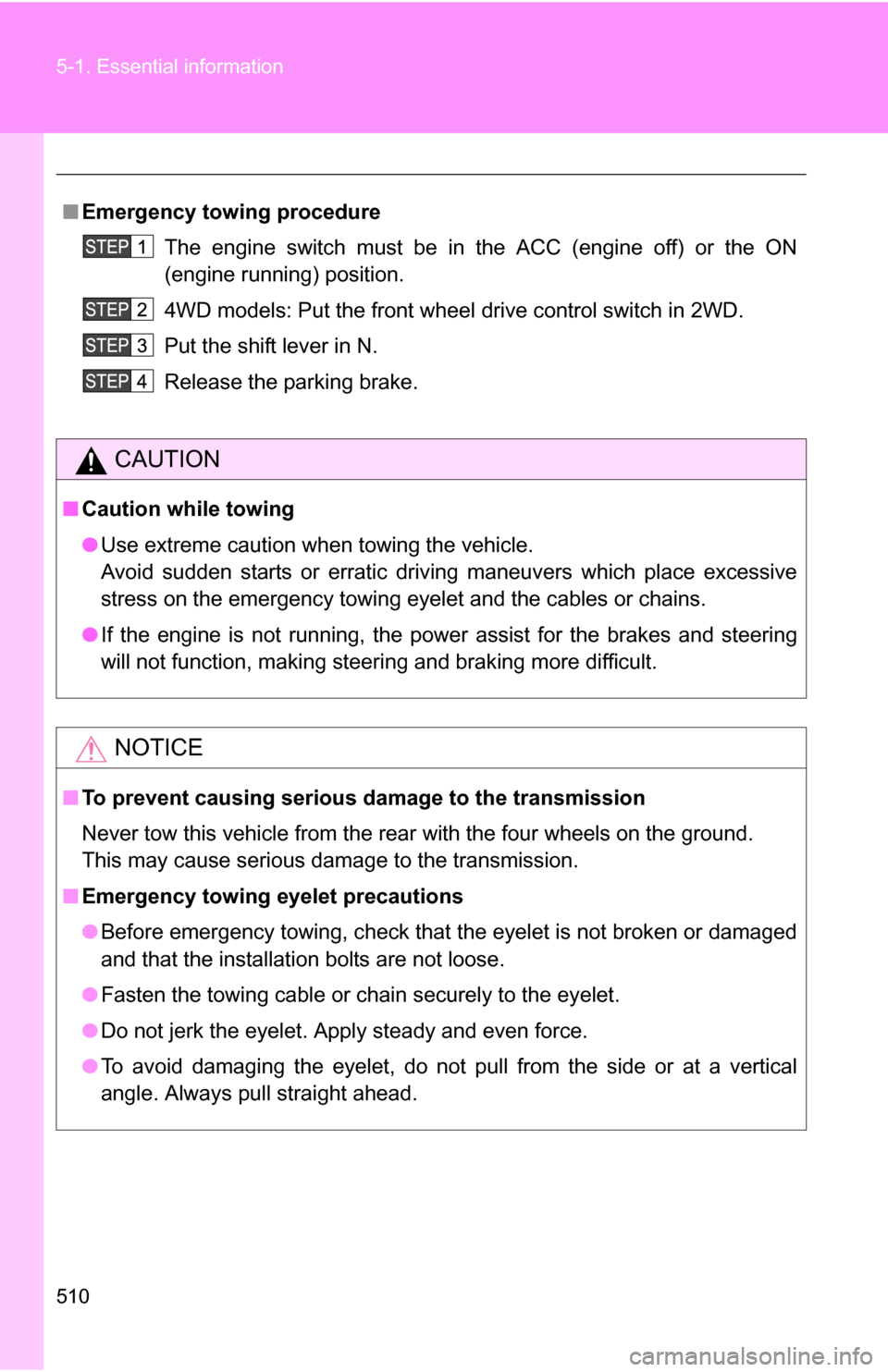
510 5-1. Essential information
■Emergency towin g procedure
The engine switch must be in the ACC (engine off) or the ON
(engine running) position.
4WD models: Put the front wheel drive control switch in 2WD.
Put the shift lever in N.
Release the parking brake.
CAUTION
■ Caution while towing
●Use extreme caution when towing the vehicle.
Avoid sudden starts or erratic driving maneuvers which place excessive
stress on the emergency towing eyelet and the cables or chains.
● If the engine is not running, the power assist for the brakes and steering
will not function, making steering and braking more difficult.
NOTICE
■To prevent causing serious damage to the transmission
Never tow this vehicle from the rear with the four wheels on the ground.
This may cause serious damage to the transmission.
■ Emergency towing eyelet precautions
● Before emergency towing, check that the eyelet is not broken or damaged
and that the installation bolts are not loose.
● Fasten the towing cable or chain securely to the eyelet.
● Do not jerk the eyelet. Apply steady and even force.
● To avoid damaging the eyelet, do not pull from the side or at a vertical
angle. Always pull straight ahead.
Trending: gas type, start stop button, child seat, warning, torque, OBD port, seat adjustment
